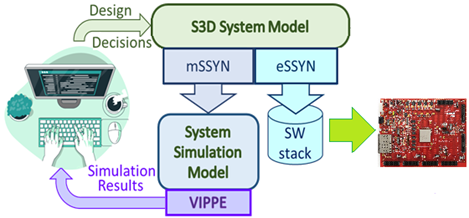WP6-25: Difference between revisions
(Created page with "== Introduction == {|class="wikitable" | ID|| WP6-HEPSIM2 |- | Contributor || UNICAN |- | Levels || Tool, Platform |- | Require || Linux, Eclipse EMF |- | Provide || Executable system level modeling, automated generation of embedded software, native execution based validation |- | Input || Platform model |- | Output || Code generation |- | C4D tooling || n.a. |- | TRL || |} S3D (s3d.unican.es) is a model-driven, system design framework around a singl...") |
|||
| Line 21: | Line 21: | ||
S3D (s3d.unican.es) is a model-driven, system design framework around a single UML/MARTE model [1]. The model is used as a centralized repository of all the information about the system which is relevant for the design. From the model, the specific information required to perform a certain simulation and performance analysis task (e.g. performance simulation of a solution in a design-space exploration) is extracted and the corresponding simulation model, synthesized. This Model-to-Model generation is performed by the mSSYN tool. The model is simulated by the VIPPE tool. It is worth mentioning that the M2M technology used to generate the simulation models automatically from the system model can be extended to synthesize the SW stack to be executed in each computational node. The corresponding synthesis tool is eSSYN (essyn.unican.es). | S3D (s3d.unican.es) is a model-driven, system design framework around a single UML/MARTE model [1]. The model is used as a centralized repository of all the information about the system which is relevant for the design. From the model, the specific information required to perform a certain simulation and performance analysis task (e.g. performance simulation of a solution in a design-space exploration) is extracted and the corresponding simulation model, synthesized. This Model-to-Model generation is performed by the mSSYN tool. The model is simulated by the VIPPE tool. It is worth mentioning that the M2M technology used to generate the simulation models automatically from the system model can be extended to synthesize the SW stack to be executed in each computational node. The corresponding synthesis tool is eSSYN (essyn.unican.es). | ||
[[File:wp6-25_I_01.png]] | |||
Revision as of 11:30, 10 January 2023
Introduction
| ID | WP6-HEPSIM2 |
| Contributor | UNICAN |
| Levels | Tool, Platform |
| Require | Linux, Eclipse EMF |
| Provide | Executable system level modeling, automated generation of embedded software, native execution based validation |
| Input | Platform model |
| Output | Code generation |
| C4D tooling | n.a. |
| TRL |
S3D (s3d.unican.es) is a model-driven, system design framework around a single UML/MARTE model [1]. The model is used as a centralized repository of all the information about the system which is relevant for the design. From the model, the specific information required to perform a certain simulation and performance analysis task (e.g. performance simulation of a solution in a design-space exploration) is extracted and the corresponding simulation model, synthesized. This Model-to-Model generation is performed by the mSSYN tool. The model is simulated by the VIPPE tool. It is worth mentioning that the M2M technology used to generate the simulation models automatically from the system model can be extended to synthesize the SW stack to be executed in each computational node. The corresponding synthesis tool is eSSYN (essyn.unican.es).
